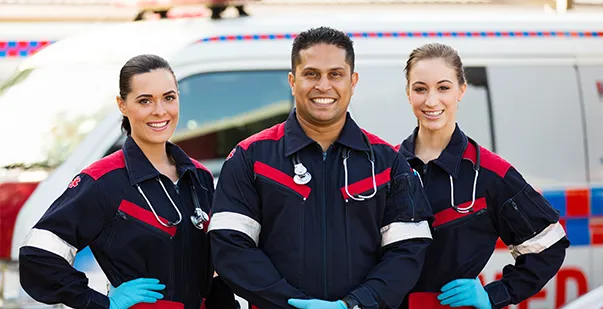When you call 911, the clock starts ticking, and behind that blaring siren is a high-stakes race involving speed, skill, and split-second decisions. Emergency Medical Services (EMS) teams aren’t just ambulance drivers; they are frontline lifesavers, delivering critical care in emergencies. National standards like NFPA 1710 aim to have Emergency Medical Technicians (EMTs) reach you in 4 minutes and paramedics in 9. But in rural areas, median response times can exceed 14 minutes.
Every emergency starts with dispatchers who answer the call, figure out how serious it is, and send the right help. EMTs and paramedics arrive at the scene, check the patient, give treatment, and get them ready to go to the hospital. On the way, they often provide life-saving care. When they arrive at the emergency room, they hand the patient over to the hospital staff. Behind every flashing light is a story of grit, precision, and compassion. Once you witness the system in action, you’ll never hear a siren the same way again.
Read More: What Is An Emergency Action Plan?
Things To Expect From An EMS Team
Every emergency call triggers a carefully planned EMS emergency response by EMS. From the moment you dial 911 to the time the patient reaches the hospital, each step plays an important role in providing fast, effective care.
If you're considering a career in emergency services, it's helpful to understand what to expect from EMS before you begin training. Let’s walk through the four key phases of an EMS response.
Step 1 – Dispatch and Mobilization
The Emergency Medical Services action begins the moment your call is answered, which starts the EMS response process to get help on the way.
Priority Coding And Its Impact On Response Time
Based on the information gathered, incidents are categorized to prioritize response:
Category 1: Life-threatening conditions, such as cardiac arrests, with a target response time of 7 minutes.
Category 2: Serious but not immediately life-threatening emergencies like strokes, aiming for an average response time of 18 minutes.
Category 3: Urgent calls, including abdominal pains, with a goal to respond to 90% within 120 minutes.
This prioritization system ensures that resources are allocated effectively, focusing on the most critical cases first.
Coordination Between Services (Fire, Police, Hospitals)
EMS teams work closely with other emergency services. For example, during a road traffic accident, they coordinate with the police and fire department. This teamwork helps keep the scene safe and makes it easier to remove patients from the scene.
They also stay in touch with hospitals. By sharing updates, they help hospitals get ready for patients before arrival. This communication makes the handoff smoother and helps patients get care faster.
Step 2 – On-Scene Protocols and Patient Assessment
Once EMS teams arrive, they follow structured protocols to assess the patient and decide the best immediate care:
Primary Assessment Using ABC (Airway, Breathing, Circulation)
When Emergency Medical Services teams arrive on the scene, they begin with a primary assessment focused on Airway, Breathing, and Circulation (ABC). This step-by-step approach helps quickly identify and address life-threatening conditions. First, they assess whether the airway is open. Next, they evaluate the patient’s breathing. Finally, they assess circulation by checking for major bleeding or signs of shock.
Following Structured EMS Protocols And Safety Checks
EMS personnel follow established protocols designed to ensure effective and safe patient care. These guidelines help determine appropriate actions such as administering oxygen, immobilizing fractures, or controlling bleeding. EMS teams also perform scene safety checks to protect both the patient and themselves, particularly in hazardous environments.
Real-Time Documentation and Information Relay
EMS providers document key details in real time, including vital signs, interventions, and patient responses. This information is communicated to the receiving hospital during transport, ensuring that hospital staff are prepared to continue care as soon as the patient arrives.
Step 3 – Roles, Equipment, and Split-Second Decisions
EMTs provide Basic Life Support (BLS), including cardiopulmonary resuscitation (CPR) and basic airway management. Paramedics deliver Advanced Life Support (ALS), performing procedures such as endotracheal intubation, intravenous drug administration, and cardiac monitoring. With advanced training, paramedics are equipped to manage critical emergencies and make rapid clinical decisions when seconds count.
Medical Equipment Used on Typical EMS Calls
EMS teams are equipped with a range of medical tools:
Airway management tools: Bag-valve masks, endotracheal tubes, and suction devices.
Cardiac care: Automated external defibrillators (AEDs) and ECG monitors.
Trauma care: Splints, bandages, and tourniquets.
Medications: Epinephrine, nitroglycerin, and analgesics.
These tools enable Emergency Medical Services personnel to stabilize patients before and during transport.
Making Protocol-Driven, Rapid Decisions
As an EMS professional, you make quick decisions using set protocols and patient assessments. For example, you might decide to give naloxone if you suspect an opioid overdose. You might also need to start rapid sequence intubation if the patient’s airway is blocked. These decisions matter. They can directly affect how well the patient does.
Step 4 – Transport and Hospital Communication
With the patient stabilized, EMS crews focus on safe transport while keeping the hospital updated for a smooth handover:
Choosing the Right Hospital and Deciding How Urgent Transport Is
When choosing a hospital, EMS teams look at several factors. They consider how serious the patient’s condition is, what services the hospital offers, and how close it is. For example, if the patient has a stroke, they may need to go to a stroke center. If the patient has serious injuries, they’ll be taken to a trauma center that can provide surgery right away.
Monitoring and Care During Transport
While on the way to the hospital, EMS providers keep a close watch on the patient. They check vital signs, help manage pain, and respond to any changes in the patient’s condition. This continuous care helps keep the patient stable and makes sure that problems are handled quickly if they arise.
Letting the ER Know Before Arrival
Emergency Medical Services personnel maintain radio or digital communication with the receiving hospital during transport. They relay key information, including the patient’s condition, interventions performed, response to treatment, and estimated time of arrival. This advance notification allows the emergency department to prepare appropriate personnel and equipment, ensuring a seamless transition of care upon arrival and minimizing treatment delays.
Why Understanding EMS Matters
Understanding Emergency Medical Services (EMS) is vital for public safety. Here are key reasons why learning about EMS makes a difference:
Better Preparedness In Emergencies
Knowing how EMS works helps you respond more effectively when emergencies happen. This knowledge builds confidence in using the system when you need it most, ensuring you’re ready to act when every second counts.Reduced Panic During A Crisis
Public awareness can help people stay calmer and take appropriate actions in emergencies. A 9-year-old girl in North Haven, reported by NBC, called 911 when she found her father unconscious. She followed the dispatcher’s CPR instructions and saved his life thanks to her quick action. Her story shows how awareness and preparedness can make all the difference.Building Trust In Ems
Clear communication about how EMS works increases people’s trust and willingness to call for help. When the public understands how EMS teams make decisions and what happens during an emergency response, it builds confidence in the system and encourages people to seek help without hesitation.The Big Picture: EMS Awareness And Trust Save Lives
Learning about EMS helps you act quickly and confidently in emergencies. Awareness ensures you trust that help will arrive when you need it most, empowering you to play an active role in the chain of survival.
Key Takeaways on Emergency Response
Every emergency call sets an EMS team into action. These professionals work together to provide life-saving care. They assess patients quickly, perform urgent treatments, and communicate with hospitals, all in a matter of minutes. When you understand this process, you can better appreciate how much skill and teamwork it takes to handle emergencies.
It also helps you build trust in the people who are trained to help you when you need it most. If you want to learn more or if you’re thinking about a career in emergency response, check out LearnTastic’s CPR + First Aid Combo Course.
References:
https://www.emergent.tech/blog/nfpa-1710-response-times
https://open.tempe.gov/pages/ee64a64c7a054bdbbcde412d14240bce










